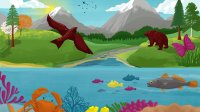Looking for Joy and Wonder in Science Class
Focusing on fun during science lessons can help elementary students develop more curiosity about the world and engage more deeply in learning.
Your content has been saved!
Go to My Saved Content.There had been a surge in a new variant. Families were stressed. Kids came in, carrying the world behind their masks. One morning, I didn’t have a chance to set up my normal greeting for students due to a parent meeting right before school. Usually, for our morning choice (soft landing) time, I dimmed the lights, put on a wildlife camera, and turned on some music that felt like something we needed.
Temperature outside below zero? Beach reggae music.
Students seem stressed and anxious? Ocean scenes, tranquil music, or joyful wildlife, playing.
But that day, there was nothing. And a student, his eyes downcast on his sketchbook, said, “Can you put on the pandas?”
Joy is a Key Emotion for Learning
Ah, yes. The pandas. The playful pandas from the Smithsonian’s National Zoo. They delighted the class. Ten-year-olds can be carrying the weight of a global pandemic, societal divisions and oppression, family changes, and climate change, and then gasp in delight at a panda climbing a tree, grabbing for bamboo, and chomping on it.
It felt like childhood. It felt like a spark of natural joy and wonder and brought them back to the moment, to their bodies, to play and joy. Students asked questions, wondered about the panda’s life, habits, and habitat. We kept a list of questions and wonderings.
When reading Ross Gay’s The Book of Delights, I was reminded that as humans, we crave simple delights, joy, and wonder. Unless we stop and see them, we can lose that sense and skill and slip into drudgery and auto-pilot mode. School can lose its meaning and become just something you have to do, separate from anything else, disconnected from the incredible world that is swirling, changing, and existing around us.
It’s important for us as teachers to give ourselves permission to slow down and not get caught up in the culture of immediacy that schools can create. We can spark joy, delight, and wonder in our students. Not only to promote a love of science, and model curious and constant learning as a way of being, but also to heal from the pains of society. It’s important to be intentional and find delight and wonder in the natural world that is struggling, yes, but abundant and all around us.
Effective Ways to Encourage Joy in Your Classroom
Here are some ways I worked out to integrate joy into my daily teaching practice.
1. Be responsive to what your class needs collectively. For example, do they need more energy? Do they need lively sea otters at play to provide laughter and energy? Or do they need to watch hundreds of jellyfish floating by to help regulate their nervous systems after recess, come down, and wonder at these fluidly moving, magical organisms?
Tune in to the social and emotional needs of your students, and let this be your guide. Doing this can also launch your class into a scientific inquiry cycle or into project-based learning.
2. Give your students permission and support to ask questions, develop curiosity, and observe deeply. They might have many questions about a plant, clouds, leaves, the soil, wildlife, the stars. Have them find spots to sit, draw, write, think, reflect, and then share with each other.
Many teachers appreciated the chance to do this during the pandemic, spending more time outside with students, with open-ended inquiries. Resist the rush-rush culture, and head outdoors or bring phenomena inside to deeply observe.
3. Play is the driver of exploring, questioning, feeling, and making meaning. Christopher Emdin makes this clear in his book STEM, STEAM, Make, Dream. He reminds us that STEM is play, and STEAM and making are play. Play, he says, is the driver of exploring, questioning, feeling, and making meaning.
How can we show students the joy of other animals playing, and how can we foster more playfulness in education and daily schooling? Games in every subject are a good place to start, resulting in laughter filling the room. These games can be a simple Kahoot, students making rap songs about scientific processes, or skits and art that illustrate new concepts or the beauty of science.
In many ways, we’ve drained the fun and play out of science by making it all about dry facts. We can bring it back through purposeful play, tinkering, and performance. For example, how can students create a zipline or a Rube Goldberg machine through play and experimentation? Play can be sorting items into categories by their characteristics and racing each other. It can look like scavenger hunts, or trial and error building a prototype.
4. Have students share what has delighted or made them curious that day. In morning meetings or circle time, each student can state an “I notice, I wonder” or a “delight” or question from the day. Or, you may want to place an anchor chart in the room where you gather students’ questions, wonderings, and delights. You can refer to it often. Kids and teachers can also use it to engage in passion projects or connect to other learning to increase relevance.
I try to do this each night as I fall asleep. What delights did I witness today? This habit then grows. You notice more delights as you note more of them.
Teachers have a chance to spark interest in science, nature, and the world around us in everyday, regular ways that benefit students by supplying joy, relaxation, wonder, and reverence. As students and teachers develop this skill, they see more delight, become more curious, and engage more with the world. This, in turn, will help them become curious, engaged, and compassionate citizens, which I think we desperately need now and into the future.
